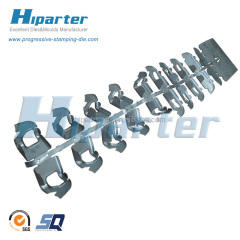





Sheet Metal Stamping Mold Custom Progressive Stamping Die
| Min. Order: | 1 Set/Sets |
|---|---|
| Payment Terms: | L/C, T/T |
| Supply Ability: | 50 sets per month |
| Place of Origin: | Shandong |
Company Profile
| Location: | Qingdao, Shandong, China (Mainland) |
|---|---|
| Business Type: | Manufacturer, Service |
Product Detail
| Model No.: | HPD22002 |
|---|---|
| Means of Transport: | Ocean, Air, Land |
| Product Material: | Metal |
| Product: | Vehicle Mould |
| Shaping Mode: | Punching Mold |
| Brand Name: | Hiparter |
| Die procedure:: | Progressive Stamping Die |
| Die material:: | DC53 |
| Equipment:: | EDM,Wire Cutting,CNC |
| Die tolerance:: | 0.02mm |
| Spare part:: | MISUMI standard |
| Production Capacity: | 50 sets per month |
| Packing: | wooden case |
| Delivery Date: | in 45 days after confirm the drawing |
Product Description
Anto Metal Parts Progressive Stamping Die
Qingdao Hiparter Metal&Plastic Products Co,.Ltd, a famous stamping die manufacturer in Qingdao, north of China, a professional manufacturer of single stage stamping dies, progressive dies, transfer dies. We are committed to die design, die manufacturing and product production, insists on providing high-standard and high-quality dies and support.






Qingdao Hiparter Metal&Plastic Products Co., Ltd., established in 2003, located in Qingdao, China. Hiparter is a professional manufacturer of single stage stamping dies, progressive dies, transfer dies, committed to die design, die manufacturing and product production, committed to stamping die manufacturing, also committed to stamping production.
During nearly 20 years of development, Hiparter insists on providing high-standard and high-quality dies and support. The dies are exported to the US, Canada, Mexico, Brazil, Argentina, Chile, Peru, Ecuador, Japan, Korea, Philippines, Thailand, India, Bangladesh, Russia, Germany, France, Italy, Norway, Poland, Australia, Egypt, Kenya and so on, more than 30 countries. We adhere to total solution service: product design optimization→die design→die manufacturing→die debugging→product inspection→die specification manual sharing→after-sales support.
1) We have experienced die design team, who will follow up the whole process from product analysis, die design, die machining, die assembly, die debugging and die acceptance, to ensure the quality of the dies.
2) We have more advantages in technical strength and experience in die manufacturing, die adjustment, die optimization and die use.
3) We insist from the customer's perspective, to carry out die design, and to provide high standard and high quality dies.
4) In the early stage of die design, fully learn the purpose of the product and the equipment information of the customers, including punching force, size of bolster, standard shut height and so on. So that the dies can be smoothly installed on the punch press once arriving at the customer's factory.
5) According to CAE analysis results, reasonably plan the die process, to provide customers with the best die scheme, and to ensure die quality and product stability.
6) Combining manufacturing experience with software analysis data, aim at judging the risk points in advance, and take optimization plan in advance. Avoid changing the product structure and die structure after die trial.
7) Provide 3D diagram of the die matching with the equipment table, easier for customers to check the matching with the equipment table.
8) Provide 3D layout drawing and die structure drawing, more intuitively and more clearly display die structure.
9) On the premise of ensuring the purpose of the product, provide adjustment suggestions, such as increasing the forming R angle, adjusting the shape and height of the reinforcement, using different height punches, increasing punching times for porous structure, etc.
10) Provide customers with standardized die design, to ensure the stability of the die, and conducive to the die structure adjustment and maintenance.
11) The die materials we used include 45#, Cr12, Cr12MoV, SKD11, DC53, SKH51, SKH-9, ASP-23, AMPCO 25, tungsten steel, etc. According to the product material, product structure, appearance requirements and so on, we will suggest appropriate die materials, to ensure the service life of the whole die and die core.
12) We usually choose a thick standard for lower die plate, which is higher than general standard. And the dies are usually stronger and more durable.
13) We also adopt some design techniques to enhance the utility of the die, such as quick change-over Inserts design, quick change plate design, quick clamping design, surface treatment design, shapes of blanking dies design, etc.

